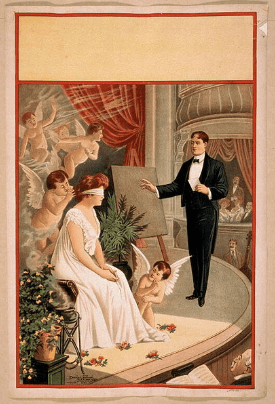An Interview with a Stage Hypnotist
Last month, I posted the first in a series of short essays adapted from an article on hypnotists and hypnotism that I wrote for (but was never published in) Harper’s magazine several years ago. What follows is the second part of the series, which focuses on my meeting with a working stage hypnotist.

I met Frank Pruden, who uses the name “Frankie Z” as a stage hypnotist, in a St. Paul, Minn., restaurant that was empty except for us. He had staked out a corner booth in the deepest recess of the establishment, and he seemed to regard all the empty seats as a challenge to fill the place with his big voice. I could see how he could send his speech to the far reaches of the high school gyms, outdoor amphitheaters, wedding halls, and fairground grandstands in which he performs.An antique advertising card showing a stage hypnotist at work
Pruden, a goateed man with receding hair, had been working a dozen years as a DJ-for-hire when one of his phobias caught up with him. Several years ago, a group of friends planned a trip to Las Vegas and asked him to come along. “You all fly. I’ll drive,” he told them. He had served as an aerial photographer in the Marine Corps, sometimes leaning out of aircraft to take pictures, but he later developed a fear of flying. “It was a control thing,” he said. “In a plane, I’d freeze up and my heart would go boom-boom.”
This time, however, Pruden realized he really wanted to travel to Las Vegas with everyone else. He tracked down a hypnotist and not only received treatment that erased his anxiety over flying, but he also signed on for training as a hypnotherapist. He soon studied stage hypnotism, as well. Right away, he began performing before audiences.
I shook my head, but I knew that I had been going under.
He thus fell into an old tradition of entertainment. Public demonstrations of hypnotism have drawn crowds in Europe and North America for more than 200 years. For much of the twentieth century, stage hypnotists offered the only exposure the public had to hypnotic techniques, and the performers developed most effective and innovative methods of induction. Some stage hypnotists spent years on the road. They typically treated audiences to demonstrations of somnambulism, lethargy, and catalepsy; brought audiences, through suggestion, to hysterical laughter; and showed how people could play musical instruments and sing while under hypnosis.
I asked Pruden to demonstrate the method of induction he uses. “I made up my own,” he said. “I ask them to take deep breaths, to let go of their thoughts, to lose the stress and tension from their bodies. I tell them to relax their muscles from their head to their feet and to go to a special place that only they know. They can float and feel relaxed on their own personal cloud.” Abruptly Pruden stopped and stared at me. “You’re not going under, are you?”
I shook my head, but I knew that I had been going under. I’m one of a minority, estimated at 20 percent of the population, who easily succumb to hypnosis. (All told, 90 percent of people can be hypnotized, which excludes those with major psychoses, mental disabilities, and other cognitive disorders.) Throughout Pruden’s patter, I felt a familiar detachment build within me, a sensation that I was suspended in the restaurant rather than sitting there. I watched Pruden’s lips move, heard his voice, and took in his words with great attention. Everything else receded to the background. The feeling was no different from when I am comfortable and relaxed while daydreaming, reading an engaging book, or spellbound in a movie theater. I have seen it in my children when time flies for them while they’re having fun at a birthday party.